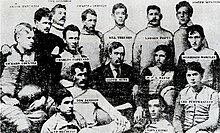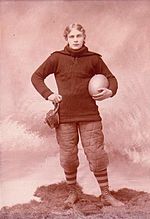The Western Pennsylvania Professional Football Circuit was a loose association of American football clubs that operated from 1890 to approximately 1940. Originally amateur, professionalism was introduced to the circuit in 1892; cost pressures pushed the circuit to semi-professional status from about 1920 through the rest of its existence. Existing in some form for 48 years, it was one of the longest-lived paying football loops to operate outside the auspices of the National Football League.
The football clubs of the 1880s and 1890s were amateur teams. They were under the membership of an athletic club, which provided both sports and the ability to wager money on the sports. However, the prestige and increased membership that could come from a successful team, led these clubs to begin secretly hiring talented players.[1] The amateur athletics that these clubs engaged in were policed by the Amateur Athletic Union (AAU).[2] By the mid-1890s allegations of professionalism became known to the AAU. The Allegheny Athletic Association was found guilty of paying cash to players and was permanently barred from any kind of competition with other AAU members. This punishment would end a team, because their opponents, whether other pros, amateur associations, or colleges, would have simply stopped playing them. Allegheny then defied the AAU in 1896 and created an entirely open professional team. A year later, the Latrobe Athletic Association, went entirely professional.[3] The misconception that these were amateur athletic clubs was held to in public, even when newspapers wrote openly of players being under contract.[4] To get around this, the circuit teams played for local or regional championships, with the only generally recognized national champion being the best college football team. However, the winner of the circuit was usually able to lay claim to a national, but professional, football title from 1890-1903.[3][failed verification]
By 1904, the exodus of pro football talent to the "Ohio League", diminished the region's level of play and the national professional champions, were usually then claimed by the teams from Ohio.[5] Though a champion was declared by the media, fans and clubs throughout this period, a formal league was not founded until 1920, when several teams from the "Ohio League" and the New York Pro Football League formed the American Professional Football Association.[6] In 1922 the APFA became the National Football League.[7]
The circuit did not immediately die out and in fact experienced a slight renaissance in the 1920s as the Western Pennsylvania Senior Independent Football Conference. 1920s era blue laws in the state of Pennsylvania meant that while the NFL played its games on Sunday, Pennsylvania teams would have to play on Saturday; while this prevented the state's teams from joining the NFL until 1924, Pennsylvania teams could thus schedule exhibition games against NFL teams on either one's day off (other circuits such as the eastern Pennsylvania circuit and the Eastern/Anthracite Leagues also thrived in the 1920s) The J.P. Rooneys were founded in 1921; it later joined the NFL in 1933 as the Pittsburgh Pirates (now the Pittsburgh Steelers). Records of the Pirates playing other Western Pennsylvania teams (including the McKeesport Olympics) continue up to at least 1940, after which point most teams dissolved due to World War II; the Pirates (by now renamed the Steelers) then shifted its exhibition schedule to other minor league teams.





